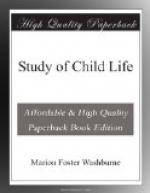[Sidenote: Intentional Grasping]
The average baby does not begin to grasp objects with intention before the fourth month. The first grasping seems to be done by feeling, without the aid of the eye, and is done with the fingers with no attempt to oppose the thumb to them. So closely does the use of the thumbs set opposite the fingers in grasping coincide with the first grasping with the aid of sight, that some observers have been led to believe that as soon as the baby learns to use its thumb in this way he proves that he is beginning to grasp with intention.
[Sidenote: Order of Development]
The order of development seems to be, first, automatism, the muscles contracting of themselves in response to nervous stimuli; second, instinct, the inherited wisdom of the race, which discovered ages ago that the hand could be used to greater advantage when the thumb was separated from the fingers; and thirdly, the child’s own intelligence and will making use of this natural and inherited machinery. This order holds true of the development, not only of the hand, but of the whole organism.
[Sidenote: Looking]
A little earlier than this, during the third month, the baby first looks upon his own hands and notices them. Darwin tells us that his boy looked at his own hands and seemed to study them until his eyes crossed. About the same then the child notices his foot and uses his hand to carry it to its mouth. It is some time later that he discovers that he can move his feet without his hands.
[Sidenote: Tearing]
About this time, three or four months old, the child begins to tear paper into pieces, and may be easily taught to let the piece, that have found their way into his mouth be taken out again. Now, too, he begins to throw things, or to drop them; then he wants to get them back again, and the patient mother must pick them up and give them back many times. Sometimes a baby is punished for this proclivity, but it is really a part of his development, and at least once a day he should be allowed to play in this manner to his heart’s content. It is tact, not discipline, that is needed, and the more he is helped the sooner he will live through this stage and come to the next point where he begins to throw things.
[Sidenote: Throwing]
In this stage, of course, he must be given the proper things to throw—small, bright-colored worsted balls, bean-bags, and other harmless objects. If he is allowed to discover the pleasure there is in smashing glass and china, he will certainly be, for a time, a very destructive little person. When later he is able to creep throw his ball and creep after it—he will amuse himself for hours at a time, and so relieve those who have patiently attended him up to this time. In general we may lay down the rule, that the more time and attention of the right sort is to a young child, the less will need to be given as he grows older. It is poor economy to neglect a young child, and try to make it up on the growing boy or girl. This is to substitute a complicated and difficult problem for a simple one.




